The
CERF–UNFPA 2019 Project, implemented by
LUKMEF–Cameroon, was designed to deliver lifesaving gender-based violence (GBV) prevention and response services and improve access to sexual and reproductive health (SRH) care for crisis-affected populations in the
North West and South West regions of Cameroon. Based on the project report and its results, the main objectives were as follows:
- Provide Timely and Lifesaving GBV/SRH Services:
Ensure that women, girls, and other vulnerable persons affected by the crisis have immediate access to lifesaving GBV and SRH services, including clinical management of rape, psychosocial support, legal aid, and referral services through the establishment of a One-Stop Safe Space in Buea.
- Enhance Community Awareness and Prevention of GBV:
Increase knowledge and awareness of GBV prevention, SRH, and human rights among displaced and host communities through door-to-door sensitizations, focus group discussions, school outreach programs, and media campaigns, ultimately reaching over 51,000 persons with key messages.
- Strengthen Local Capacities for GBV and SRH Response:
Build the technical and operational capacities of service providers, community focal persons, and local organizations to identify, manage, and refer GBV cases appropriately. This included training 20 service providers and 30 community mobilizers in Buea, Mutengene, Tiko, Limbe, and Mamfe.
- Improve Access to Essential Hygiene and Reproductive Health Supplies:
Support women and girls of reproductive age, including survivors of GBV, with Dignity Kits and Mama Kits to promote menstrual hygiene, safe childbirth, and restore dignity. Over 5,000 kits were distributed to identified vulnerable beneficiaries.
- Promote Survivor Empowerment and Livelihood Recovery:
Provide livelihood training and economic support to GBV survivors to help them rebuild self-reliance, reduce vulnerability, and prevent cycles of dependency and exploitation.
- Foster Coordination and Partnership in GBV/SRH Interventions:
Strengthen coordination between humanitarian actors, community mobilizers, and local service providers through training workshops and working sessions with UNFPA leads and experts to improve accountability, data collection, and referral systems in the field.
Through these objectives, the project sought to
reduce the incidence and impact of gender-based violence,
restore dignity to survivors, and
enhance access to quality reproductive health services in the crisis-affected North West and South West regions of Cameroon.
The CERF–UNFPA 2019 project implemented by LUKMEF–Cameroon delivered impactful and lifesaving GBV and SRH interventions across Fako and Manyu Divisions in the South West Region. Over 51,726 individuals (31,721 females and 20,005 males) were reached through sensitization campaigns, focus group discussions, and outreach activities in schools, churches, and communities. A One-Stop Safe Space was established in Buea, providing comprehensive case management, psychosocial support, legal aid, and livelihood services to 798 survivors. Over 5,039 kits (Dignity and Mama Kits) were distributed, alongside 128 economic support packages. The project also trained 50 local actors—service providers and community mobilizers—enhancing community-based response mechanisms. Through extensive media campaigns on radio and television, over 252,000 people were sensitized on GBV prevention and SRH. These achievements significantly improved awareness, survivor assistance, and coordination of GBV/SRH responses in crisis-affected communities
Implementation was hampered by persistent insecurity, frequent lockdowns, and the volatile nature of the crisis in the North West and South West regions. Many communities remained inaccessible, leaving vulnerable populations in remote “bush” settlements unreached. Limited funding restricted the scale of interventions, particularly for survivors requiring continuous psychosocial or livelihood support. Cultural barriers, stigma, and fear of reprisal discouraged some survivors from reporting GBV incidents. The shortage of trained psychosocial counselors and legal practitioners within the crisis zone further constrained response capacity. Weak infrastructure and the destruction of health facilities also affected service delivery and referral pathways. Additionally, logistical difficulties such as poor road networks, high transport costs, and communication breakdowns during field activities reduced efficiency. Despite these constraints, the project achieved remarkable results due to strong coordination, community trust, and the commitment of frontline actors under very challenging circumstances.
The project highlighted the importance of integrating GBV and SRH services within humanitarian response frameworks. Establishing a One-Stop Safe Space proved that a centralized, survivor-centered model enhances accessibility and confidentiality, fostering trust among survivors. Engaging community mobilizers and local structures strengthened community ownership and ensured sustained outreach even in hard-to-reach areas. Collaboration with media houses amplified message coverage, showing the power of communication in behavioral change. Training local actors built a foundation for sustainable service delivery beyond the project’s lifespan. Furthermore, distributing Dignity and Mama Kits not only met immediate needs but restored dignity and encouraged health-seeking behavior. The project also demonstrated that effective coordination between local NGOs and UN agencies enhances accountability, standardization, and impact. Above all, it underscored that local organizations, when adequately resourced and trained, can deliver high-quality humanitarian services comparable to international actors.
Future interventions should prioritize scaling up the Safe Space model to other divisions and improving mobile outreach to reach survivors in inaccessible areas. Strengthening partnerships with local CSOs and health institutions will ensure wider coverage and sustained impact. Increased and predictable funding is essential to maintain continuous psychosocial and livelihood support for GBV survivors. More investment in capacity building—especially for social workers, legal aid providers, and health personnel—is needed to enhance quality service delivery. Expanding media campaigns and community dialogues can further reduce stigma and promote behavioral change. Integrating disability-inclusive approaches and targeted interventions for adolescents and men will fill existing gaps. Improved coordination between government, humanitarian actors, and local NGOs should be institutionalized to harmonize GBV/SRH response frameworks. Above all, sustained donor support and community-driven participation remain critical for consolidating the project’s gains and replicating its success across other affected areas.





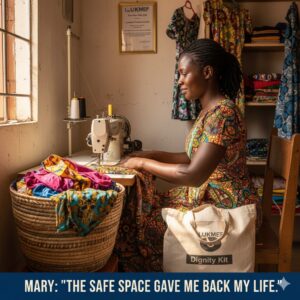 From Silence to Strength: The Journey of a Survivor in Buea
From Silence to Strength: The Journey of a Survivor in Buea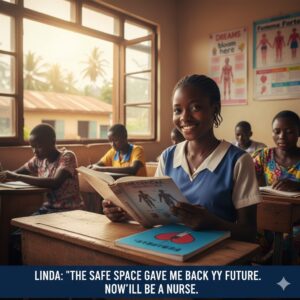 A Girl Saved from Child Marriage in Mamfe
A Girl Saved from Child Marriage in Mamfe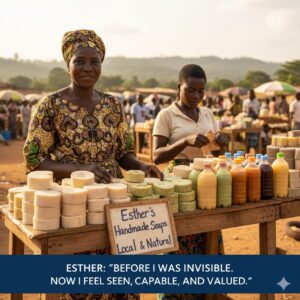 Restoring Hope through Livelihood Empowerment in Limbe
Restoring Hope through Livelihood Empowerment in Limbe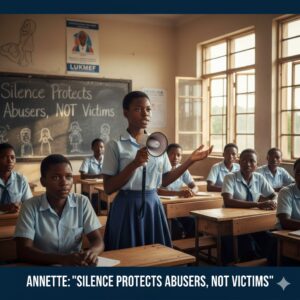 The Student Who Found Courage to Live Again
The Student Who Found Courage to Live Again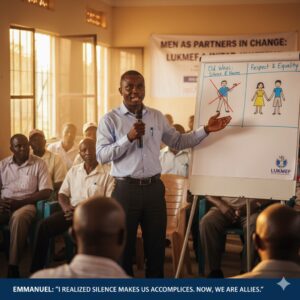 Men as Partners in Change: The Story of Emmanuel
Men as Partners in Change: The Story of Emmanuel